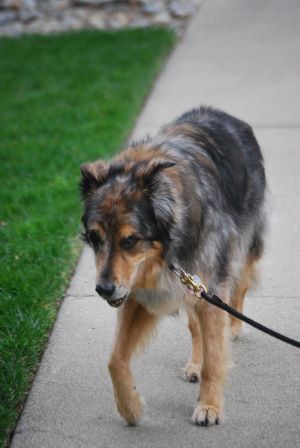
If your dog begins to stumble on its front legs, they could be suffering from a wide range of medical issues, anywhere from neurological deterioration to a spinal injury.
The dog’s stumbling may appear like paralysis in its front legs or as general clumsiness.
Both types of stumbling can be indicative of more serious issues. Loss of balance in dogs is not normal and should not be ignored.
If your dog shows signs of any of the following issues, you should schedule an appointment with your vet as soon as possible.
If your dog cannot walk or stand at all, a trip to the emergency vet may be needed.
The vet will probably run a number of tests such as physical examinations, mobility tests, X-rays and blood work to determine the source of the problem.
Diagnostic imaging may be done to identify whether the paralysis is related to the nervous system, skeletal system or muscular system.
With an accurate diagnosis, your vet will be able to lead you and your dog on a treatment path based on their condition. Listed below are some possible diagnoses:
(1) Spinal Injury
This is the most common cause of paralysis in dogs’ legs, causing them to stumble about.
After a direct blow to the shoulder or when the front leg is pulled out from the body, the shoulder’s nerve tissue may detach from the shoulder joint, causing a brachial plexus avulsion.
Symptoms
- Inability to bear their weight
- Severe weakness
- Loss of sensation below the elbow, causing the dog to flex their wrist and drag their paws against the floor. Vets refer to this as “knuckling over.”
- Occasionally eye abnormalities such as sunken eyes, droopy eyelids and smaller pupils.
Common Causes
- Falls
- Automobile accidents
- Gunshot wounds
Possible Treatments
- Bandages and protective boots
- Physical therapy
- Anti-inflammatory medication
(2) Arthritis
Osteoarthritis is a common cause of stumbling, especially in older dogs. After a diagnosis, your vet can help you come up with a plan of treatment for your dog.
Symptoms
- Inflamed and painful joints
- Muscle atrophy
- Weakness in legs
- Less movement
Common Causes
- Cartilage breakdown
- Old age
- Previous injury
- Obesity
- Infection
- Genetics
Possible Treatments
Although no known cure exists for osteoarthritis, certain steps can be taken to mitigate the pain.
- Healthy diet
- Exercise
- Joint supplements
- Prescribed medication
- Physical therapy
(3) Tumors
Nerve sheath tumors can trigger paralysis in parts of the dog’s body. Several diagnostic tests such as myelograms, CT scans and MRIs may be needed to confirm or rule out tumors.
Symptoms
- Pain when touching the armpit area or moving the leg
- Chronic paralysis in one leg that gradually worsens
- You can feel a large mass
- Muscle atrophy
Common Causes
Unknown. Nerve sheath tumors can grow for no known reason and affect the neighboring tissue.
Possible Treatments
- Surgery to remove the tumor
- Amputation of the affected leg
- Spinal surgery if the tumor spreads into the spinal canal
- If surgery cannot be performed, radiation therapy may be an option
(4) Brain Tumor
In older dogs, a brain tumor may be the cause of stumbling and loss of balance. Brain tumors do not cause paralysis, but rather a general clumsiness in the legs.
Symptoms
- Staggering, stumbling and loss of balance
- Changes in behavior and appetite
- Seizures
- Signs of pain
- Head tilt
- Swaying
- Wide stance
- Lack of coordination
- Head tremors
- Flicking of the eyes
- Pacing
- Circling
Common Causes
There is no known definitive cause of brain tumors in dogs.
Possible Treatments
- Neurosurgery
- Radiation therapy
- Chemotherapy medication
- Steroids
- Medications for seizures
(5) Ataxia
Ataxia refers to incoordination of the nervous system. While it can occur anywhere in the dog, we are focused on ataxia in the spinal cord, since that is where front leg issues would arise.
Symptoms
- Staggering, stumbling and falling over
- Head tilt
- Circling
- Vomiting
- Nausea
- Flicking of the eyes
Common Causes
- Loss of spinal cord tissue (also known as degenerative myelopathy)
- A stroke to the spinal cord
- Abnormality of the spinal cord
- Tumors in the spine or spinal cord
- Inflammation of the spinal cord
- Trauma to the spinal cord
- Infection in the vertebrae or intervertebral discs
- Instability in the spine
- Narrowing of the spinal canal
Possible Treatments
- Pain management
- Pain, inflammation or infection medication
- Braces
- Supplements
- If caused by tumors and cancer, chemotherapy, radiation therapy and surgery may be needed
(6) Ear Infections
If your dog is more wobbly or clumsy on his front legs than paralyzed, they may have an inner ear infection. The inner ear is what controls dogs’ sense of coordination and balance. If infected, dogs can become disoriented and their proprioception can be affected.
Symptoms
- Loss of balance
- Head shaking
- Scratching
- Circling
- Flicking of the eyes
- Redness, swelling, discharge and odor in or around the ear
Common Causes
- Bacteria in the ear is the most common cause
- Yeast
- Fungus
- Ear mites
- Foreign objects in the ear
- Physical trauma
- Tumors
- Polyps
Possible Treatments
Your vet may thoroughly clean your dog’s ears using a medicated cleanser. They may also prescribe any of the following:
- Ear cleanser
- Topical medication
- Oral antibiotics and anti-inflammatory medications
(7) Head or Inner Ear Injury
Injuries to the head or inner ear can also cause dogs to lose their balance and sense of coordination. Your dog may have a concussion or damage in the inner ear.
Symptoms
- Loss of balance
- Heavy panting
- Slowed reflexes
- Change in Appetite
- Enlarged pupils
- Anxiety
- Reluctance to lie down.
Common Causes
- Automobile accident
- Altercation with another dog
- Falls
Possible Treatments
- Bandages on the ear
- Pain medication
- Oxygen
- IV fluids
- Medication to expel water and salt
- Steroids
- Surgery in severe cases
(8) Brain Inflammation
Also known as encephalitis, brain inflammation can occur in your dog for a wide range of reasons. Encephalitis can often be cured or mitigated if identified early and treated aggressively. Young and middle-aged dogs as well as smaller breeds are more prone to encephalitis.
Symptoms
- Loss of balance
- Seizures
- Disorientation
- Changes in behavior
- Circling
- Spinal pain, particularly in the neck
- Occasionally fever
Common Causes
- Bacterial, viral, fungal or parasitic infection of the brain
- Malfunctioning immune system
Possible Treatments
Treatments depend on the cause of the brain inflammation but can include:
- Antibiotics
- Anti-fungal medication
- Medications that suppress the immune system
- Steroids
(9) Vestibular Disease
Often related to the brain and the inner ear, vestibular disease is a sudden, non-progressive loss of balance and coordination, usually in older dogs. Most of the time, the symptoms can resolve on their own after several weeks.
Symptoms
- Sudden loss of balance
- Disorientation
- Head tilt
- Flicking of the eyes
- Leaning or falling in the direction of the head tilt
Common Causes
- Middle or inner ear infections
- Medications toxic to the ear
- Physical trauma or injury
- Tumors
- Hypothyroidism
Possible Treatments
- IV fluids
- Sedatives
- Nausea medication
- Antibiotics
(10) Wobbler Syndrome
Common in larger breeds, particularly Doberman pinschers, Wobbler syndrome is a disease of the neck that affects the spinal cord and spinal nerve roots.
Symptoms
- Loss of balance
- Lack of coordination
- Muscle atrophy
- Knuckling over
- Neck pain
- Weakness
Common Causes
At this time, there is no known cause for Wobbler’s syndrome. Some believe that genetics may play a factor, but there is no evidence to support that claim yet.
Possible Treatments
- Pain management and medication
- Anti-inflammatory medication
- Activity restriction
- Use of chest harness over neck leash
- Surgery
(11) Intervertebral Disc Disease (IVDD)
IVDD is a degenerative disease caused by a ruptured, slipped, bulging or herniated disc that can cause pain and mobility issues in your dog.
Symptoms
- Partial loss of movement
- Stumbling
- Peculiar gait
- Paralysis
- Weakness
- Stiffness of the neck
- Back pain
- Crying or yelping when handled or picked up
- Shivering
- Reluctance to run or play
Common Causes
- Gradual physical trauma over time (i.e. jumping on the couch, hard landings…)
- Old age
- Severe injury
Possible Treatments
- Pain medication
- Anti-inflammatory medication
- Cage rest
- Physical therapy
- Surgery
(12) Stroke
Strokes in dogs are more uncommon than the other injuries and illnesses listed, but they are still a possibility. If you suspect your dog is having a stroke or has had a stroke, take them to the vet immediately.
Symptoms
- Loss of balance
- Head tilt
- Circling
- Falling down
- Loss of vision
Common Causes
- Blood clots
- High blood pressure
- Hemorrhage
- Head trauma
- Kidney disease
- Migrating worms
Possible Treatments
While there is no specific treatment for the damage already done by a stroke, your vet will work towards finding the underlying cause of the stroke and, if possible, treating it to prevent future strokes.
Conclusion
If your dog is experiencing symptoms of any of these conditions, your best bet will be to take them to the veterinarian. While we hope this article was informative, only a vet can provide an in-depth diagnosis for your dog and their particular situation. Before your appointment, be sure to list all the symptoms your dog is experiencing, when they started and how often they occur to best help the vet in treating your dog.





